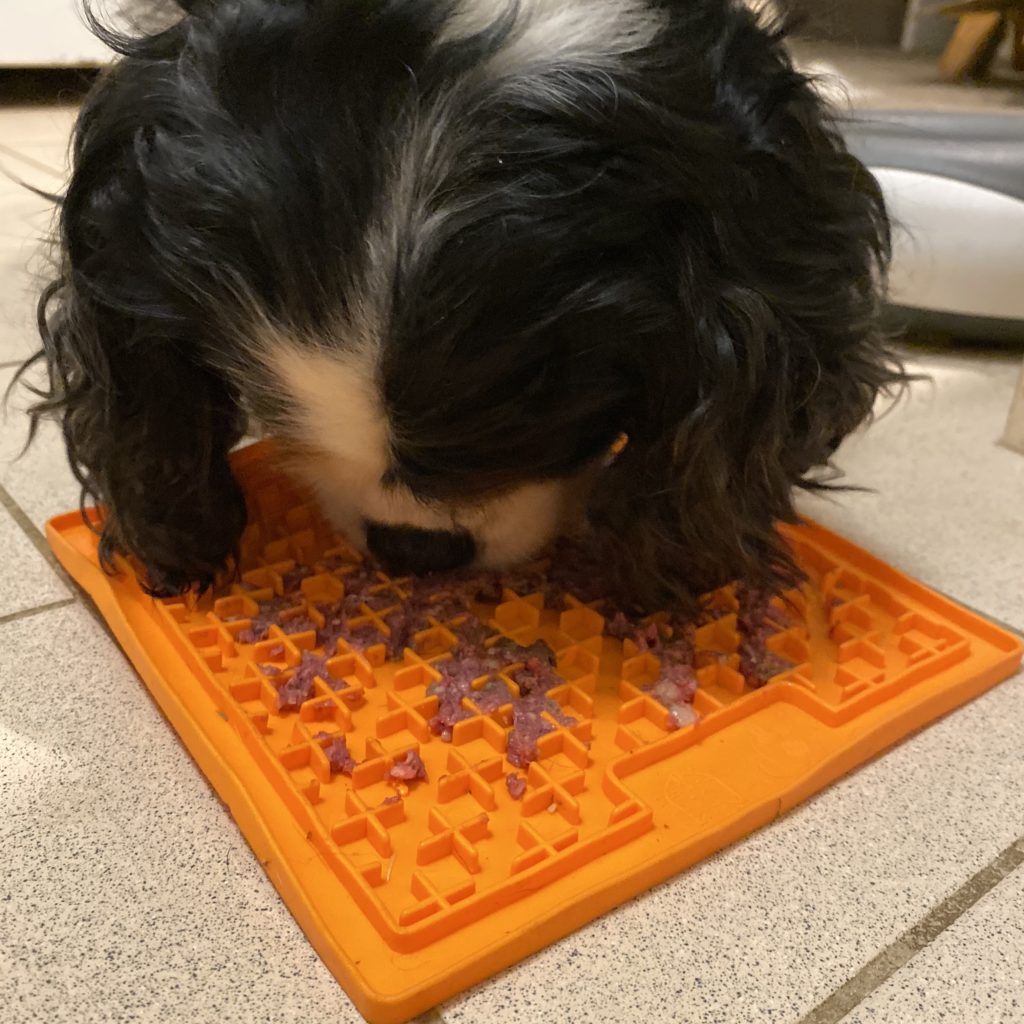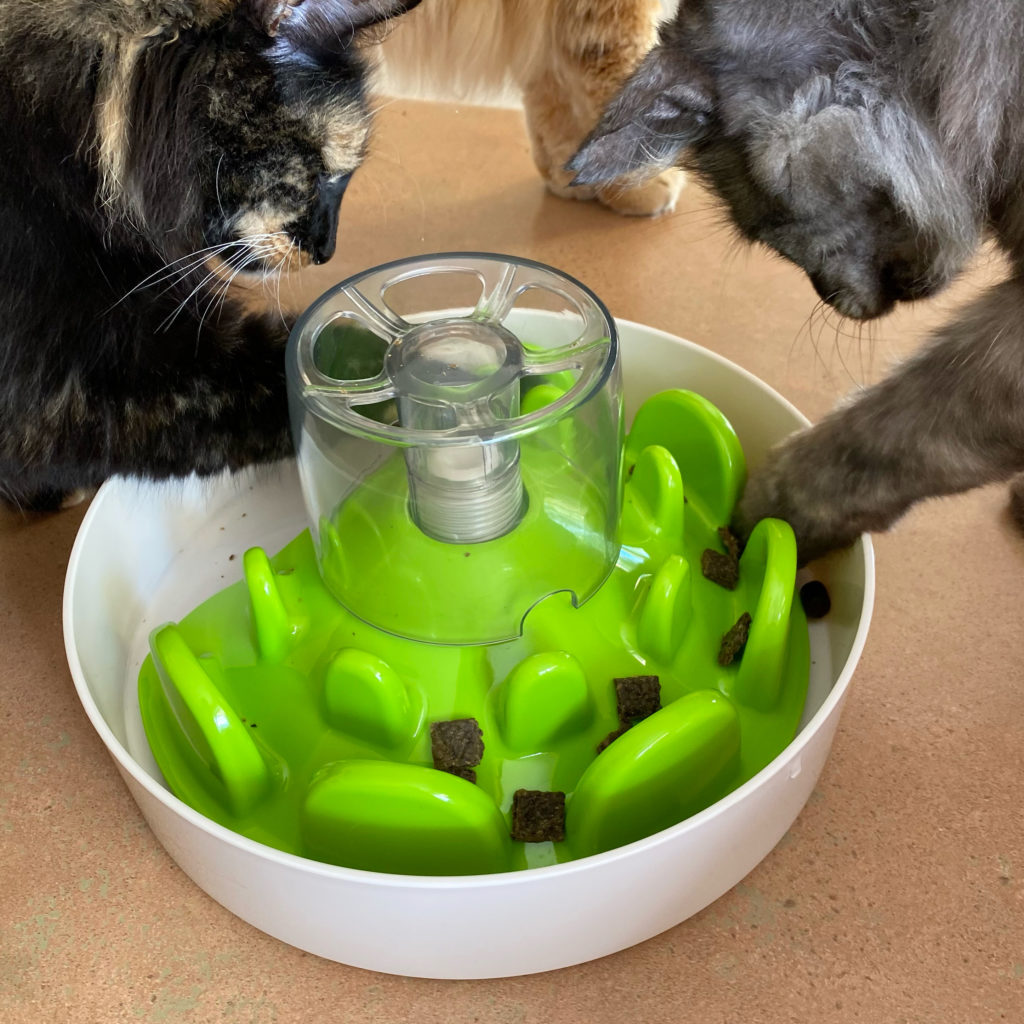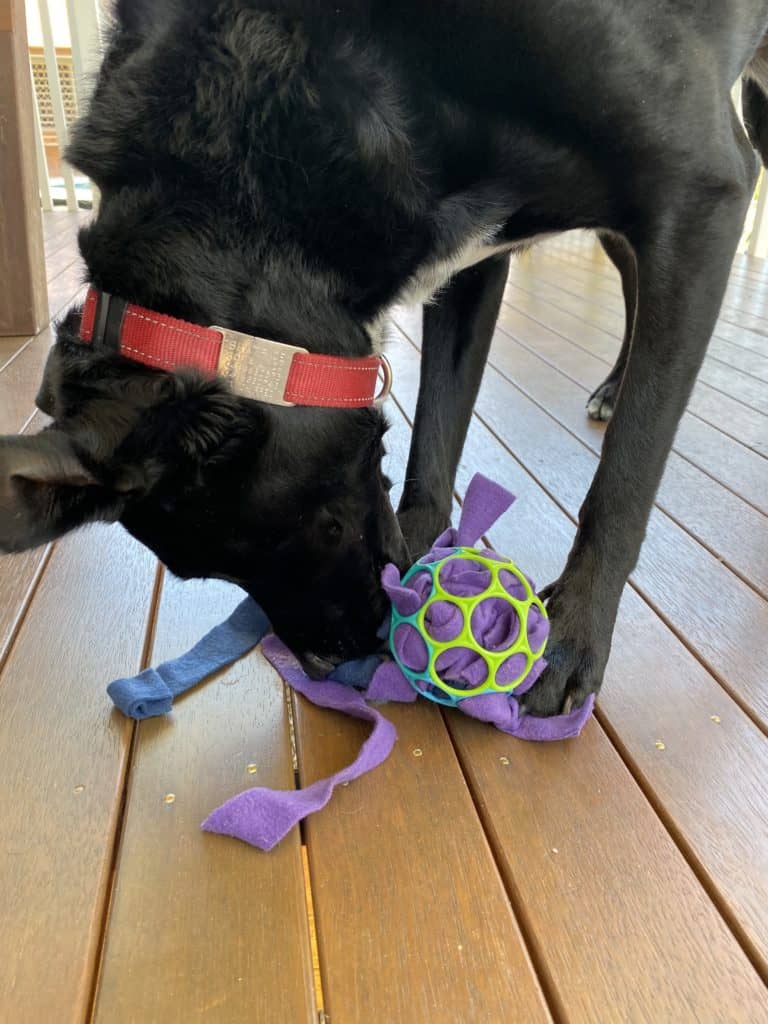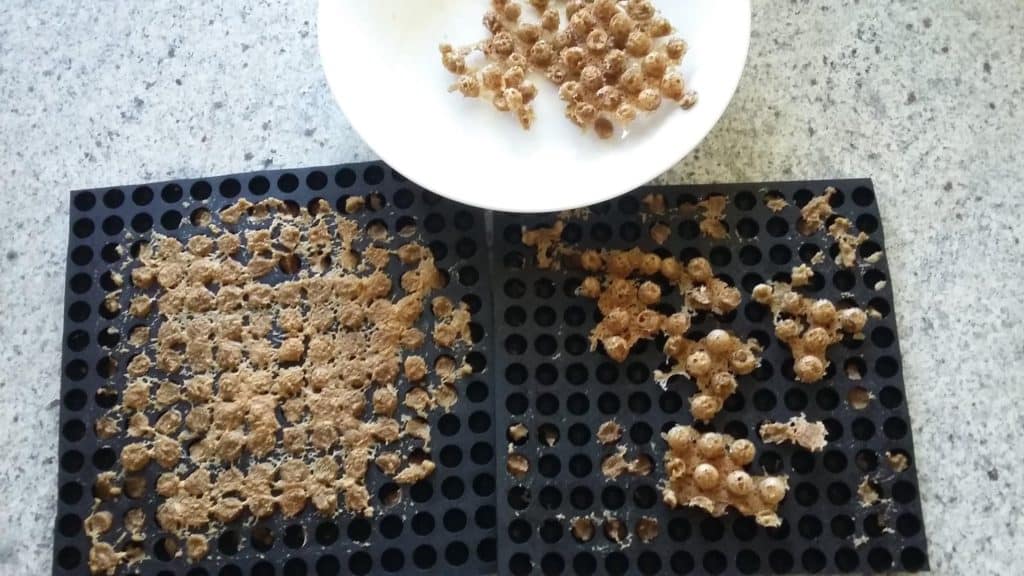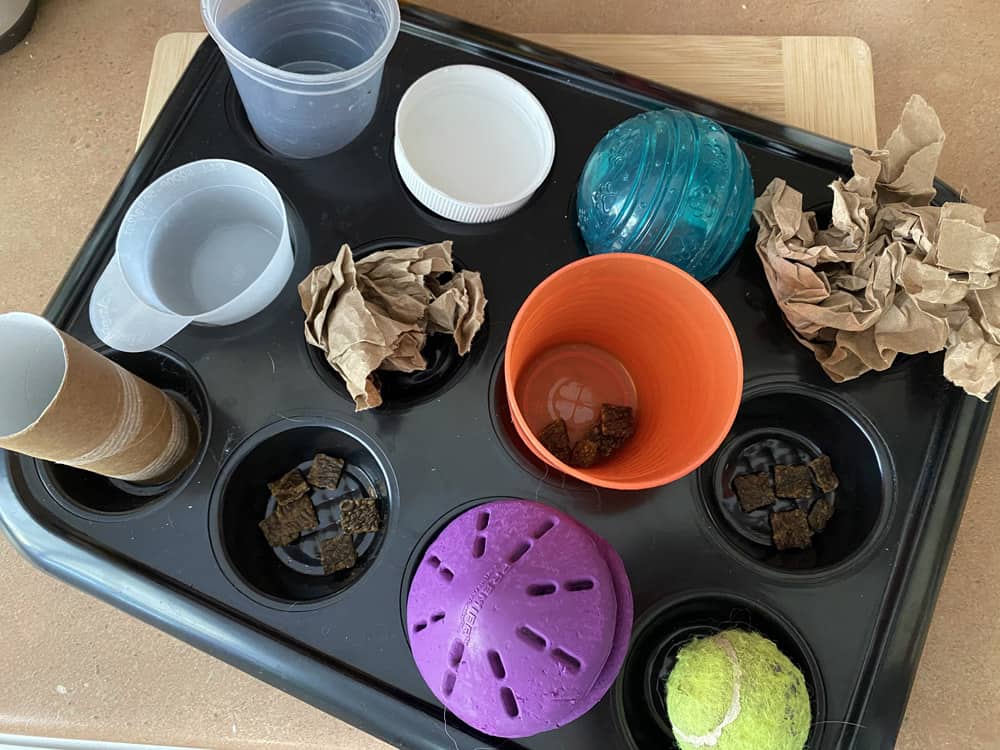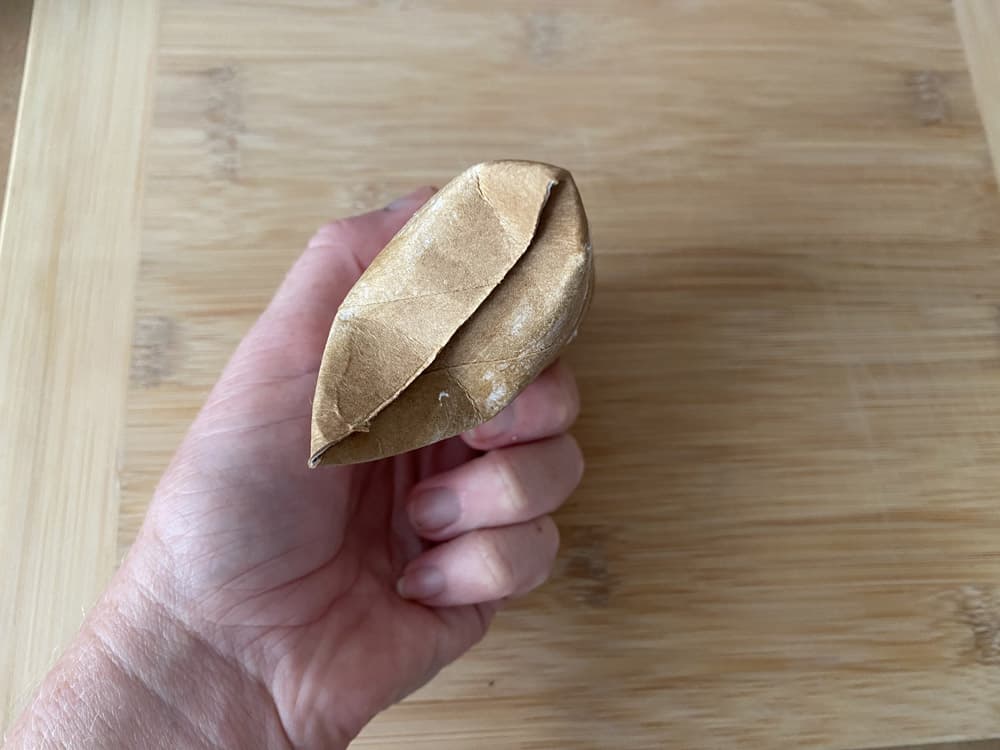
When your dog or cat is on a restricted or specialised diet, it can take the shine off meal time, even for those who are normally enthusiastic about food. Eating the same thing for every meal, presented in the same bowl, certainly has its limitations in terms of providing natural enrichment opportunities. Ideally, we want to provide our dog or cat with daily foraging, sniffing and mentally engaging activities for optimum wellbeing.
Mental, physical and emotional wellbeing are all linked, so if one area is lacking, it will have a detrimental effect on the others. If you have deficits in any or all of those areas, it will impact their behaviour and trainability. All of this, has a cyclical effect, so it’s important to find ways to meet their mental and emotional needs. If these needs are not met, it can have a flow on effect, exacerbating medical and nutritional concerns.
It can be frustrating and stressful when they are not interested in their food or are reluctant to eat. If food is usually one of your pet’s biggest reinforcers and motivators, a restricted diet can often make it very challenging to use in training sessions. Pet guardians are often unaware of what options they have available to help make their pet’s food more interesting and engaging. Often they think that food puzzle activities are not an option or not worth trying.
Whether the diet restrictions are short term or long term, here are 5 tips you can try to make their food more enticing for enrichment, training, or everyday meals.
1. Use Food Puzzle Toys, Activities & Training to Feed
Whilst the food itself in a bowl may not create much joy, implementing meals in a fun and engaging way alone, may create more a positive association and interest. Two easy and no cost activities you can try are scatter feeding and nosework (Find It). Most dogs love to scavenge, forage and sniff- that’s often more fun than the food itself! To scatter feed, grab a small amount of their food and scatter around on the ground – inside or outside. Keep it simple at first if they haven’t played this before so the pieces are close together and easily visible. If it’s wet/canned food this can be done with little spoonfuls or try some of the other suggestions coming up.
We add variety to scatter feeding by playing the game inside, outside and on different surfaces (long grass, concrete, garden etc). Also try a foraging tray, plastic bottle, cardboard tube (toilet roll) or sand digging pit – they get to dig for treats, which satisfies multiple natural needs at the same time.
Nosework is looking for pieces hidden around the environment, in and around things. If you are going to try this, start simple so they understand what the game is but putting the food visually in front of them, then gradually hiding it in or on things. Check out your local nosework (scentwork) instructor for a course or class to have someone assist you and your dog.
Try DIY food activities or specially designed food puzzle toys like LickiMats, KONG Classic, KONG Gyro, KONG Wobbler, West Paw Rumbl, West Paw Toppl, CatIt or Nina Ottosson puzzle toys or Snuffle Mats, just to name a few. Some of those are marketed for dogs, some for cats and some can be used both both. Many of those activities are designed for dry food or treats, but may be adaptable to mixed feeding. A snuffle mat is a condensed version of scatter feeding to a shaggy, usually fleece stripped, mat. You can buy one or make your own if you are feeling crafty.
If your dog loves training, use food for training sessions, mat training or recall games (they can chase thrown food and then you recall them back for another repetition). You can also incorporate their food into physical conditioning sessions to build up physical strength and flexibility. The delivery of their food into a novel activity will often increase in their interest in the food.
2. Different Varieties/Version of the Recommended Diet
If you are feeding commercially produced specific or veterinary prescription diet, they often have the prescribed products in different forms. For example, there is often a canned food version, in addition to dry food. Some diets may have multiple flavour varieties available to you. Having different physical options of the recommended diet, can give variety in itself. Different formation of the food can also give you more options with other food activities. You can use canned food in LickiMats or mix dry and canned in KONGS or for nosework activities.
Sometimes you have another brand or food alternative available to your pet, that still meets their medical needs. Consult with your vet or a nutritionist for other food options to suit your pet’s condition. Prime100 rolls, for example, are fully balanced and veterinary approved. Single protein rolls, these are a great option for dogs with a variety of medical concerns from food elimination and allergies, through to low fat (pancreatitis). As a cooked meat roll, they are often high value to dogs and may be suitable to use for training treats (as is or dehydrated), mixed feeding or even as a meal alternative.
3. Changing the Food’s Physical Form
Another great way to add some interest is to change the food into a different physical form. Sometimes its as simple as just changing the temperature, by slightly warming, cooling or even freezing it. Cats tends to prefer room temperature or lightly warmed, dogs can vary in their preference. By altering its form, it can change both the texture and flavour, which may make it more interesting and palatable for your dog or cat. For dry food you could add water or another appropriate liquid or ingredient to turn it into a smoothie or a paste. If you have canned or moist food, you could puree the food, or cut up into cubes or slices, then bake, air dry or dehydrate into chewy or crunchy pieces. Dog food ice blocks are a fun option, especially in warmer months.
One of our very clever friends got super creative and made kibble ‘popcorn’. She soaked dry food overnight, blended the mixture, poured into a silicone dot mould and microwaved it, turning it into airy, crunchy ‘popcorn’. See pics below of her popcorn and other food formation changes.
4. Safe Food Toppers or Mixers
Pet guardians are often unaware they may be able to safely add other foods in small amounts to the existing diet. You may be able to include simple stocks or bone broths. For many dogs, cooked veggies or pureed fruit may be a safe and suitable option. Some dogs can manage small pieces of cooked meats or a sprinkle of parmesan cheese. What you can add will very much depend on your individual pet and their needs, but don’t be afraid to investigate foods you may be able to add in small amounts or to use as occasional treats or chews.
5. Research & Engage Professional for Dietary Advice & Options
Last but not least – look into more options! The wonderful thing is that science is always evolving and there are lots of different professionals with new information and experience coming to the forefront every day. Whether the dietary restrictions are short term or long term, if your pet is having trouble on the diet they are on, emotionally or medically, don’t assume you are out of options. Sometimes they aren’t interested in food because they don’t feel well, so this needs to be closely monitored. Don’t be afraid to seek help to explore the possibilities with different foods, proteins, brands, supplements and medications to manage the situation more effectively, or to increase their appetite. You may discover new meal options, mix ins, toppers, treats or chews to help your pet, which ultimately can increase their quality of life.
Nutrition is an in depth area that is constantly changing, so its often worth engaging a qualified animal nutritionist, veterinary nutritionist and/or integrative/holistic animal professional to assist with an individualised diet, program or advice tailored specifically for your dog or cat. That professional assistance may provide your pet with more options, even if just for treats or chews. Be mindful of well intentioned advice from friends, family or people on the internet, as it may not suit your dog’s individual needs. If you have any more ideas to share to help other people, we’d love to hear them!



